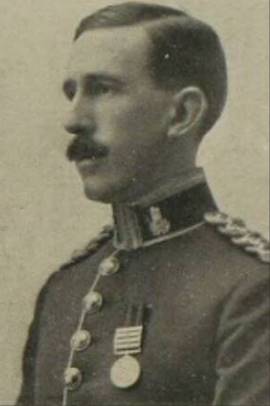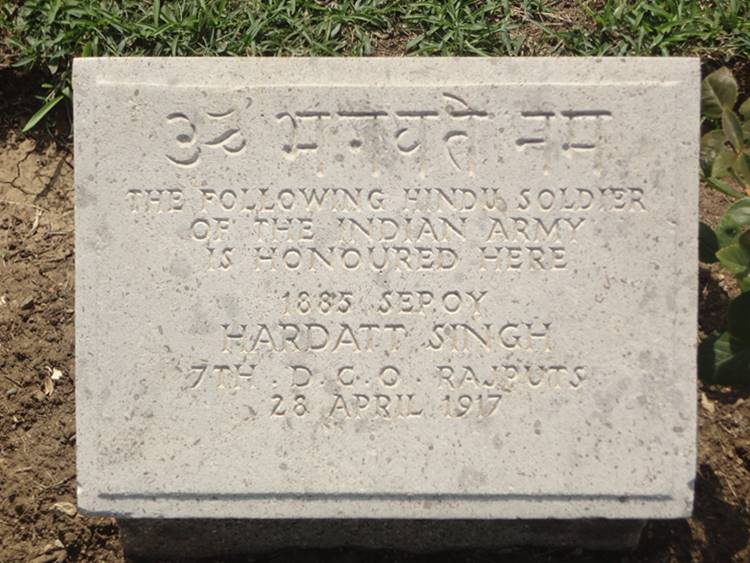This article is about the 7th (Duke of Connaught’s Own) Rajputs and will help you to research the Regiment and the soldiers who served with it during the First World War. I have written a separate article for the short-lived 2nd Battalion, 7th Rajputs and a series of guides to help you to research soldiers who served in the Indian Army. To view the guides click on the blue links below:
- 2nd Battalion, 7th (Duke of Connaught’s Own) Rajputs
- Researching Soldiers who Served in the Indian Army
The 7th (Duke of Connaught’s Own) Rajputs in the First World War
Lineage: Raised at Cawnpore (Kanpur) by Captain P. Crump as the 1st Battalion, 24th Native Infantry in 1804. Then in 1824, became the 47th Native Infantry, was disbanded and raised again as the 69th Native Infantry. In 1828 it once more became the 47th Native Infantry and in 1861 7th Bengal Native Infantry. In 1883, the 7th (Duke of Connaught’s Own) Bengal Native Infantry and the 7th (Duke of Connaught’s Own Rajput) Regiment of Bengal Infantry in 1893. In 1903 the Regiment became the 7th Rajputs (Duke of Connaught’s Own) and then the 3rd Battalion, 7th Rajput Regiment in 1922.
Class Composition of Battalion in 1914: 8 Companies of Rajputs. 1919: 4 Companies of Rajputs.
Location in August 1914: The 7th Rajputs was stationed at Ahmedabad (Gujarat, India) having arrived from Jask, Persian Gulf (Iran) on 6th December 1912.
The 7th Duke of Connaught’s Own Rajputs was mobilized for active service on 7 September 1914 while it was stationed at Ahmedabad (Gujarat, India). The 7th Rajputs served as part of the 18th Indian Infantry Brigade, 6th (Poona) Division in Mesopotamia (Iraq). If you are interested in the Regiment I would recommend viewing its war diary which provides a wealth of information. The Regiment was besieged at Kut-al-Amara (7 December 1915 – 29 April 1916) and captured by the Turkish forces when the town fell in April 1916. Soldiers taken prisoner by the Turks suffered from awful treatment and many died while prisoners of war. The 7th Rajputs have a total of 490 men commemorated by the Commonwealth War Graves Commission, one of the highest totals for any Indian regiment during the war.
Captain William Gover, 7th Rajputs who was killed in action on 3 March 1915 at Ahwaz, Persia (Iran) and is commemorated on the Tehran Memorial. The medal which Gover was wearing is the Queen’s South Africa Medal with four clasps. Gover’s portrait was published in the Illustrated London News, 20 March 1915.
The Regiment was stationed at Aden in the January 1920 Indian Army List and subsequently at Santa Cruz, Bombay (Mumbai) from the 25 April 1921. In 1922 the 7th Rajputs became the 3rd Battalion 7 Rajput Regiment in 1922. A second battalion was formed at Alipore on 16 June 1918 and served in Mesopotamia before it was disbanded on 20 August 1921. I have written a separate article about the Battalion here: 2nd Battalion 7th Rajputs.
War Diary of the 7th Rajputs
There is only one war diary for the Regiment which has been digitized and can be downloaded from the National Archives. To download the war diary for a small fee click on the blue link below. I have transcribed some entries from the war diary at the bottom of the page.
- Date: 07 September 1914 – 30 October 1915
- 18th Indian Infantry Brigade, 6th (Poona) Division
- Reference: WO 95/5124/3
- Notes: The 7th Rajputs’ war diary is excellent and one of the most detailed produced for any Indian unit during the war. Between September 1914 and February 1915, the war diary is written by Captain Ogg, who doesn’t have the neatest of handwriting. There is a detailed account of the “Report of Action of 3 March 1915” as an appendix. Between April and August 1915 very little occurs and the war diary is mostly concerned with the weather. Also contains an extract transcribed from Force Routine Order July 1915 with a list of Indians awarded gallantry medals, with full citations. 2 appendices on the Action at Es Sinn on 27 and 28 September 1915. This war diary has been digitized and is available to download from the National Archives’ website.
Further Sources for the 7th Rajputs
For information regarding the British and Indian officers who served with the 7th Rajputs, the Indian Army List should be consulted. The Regimental Confidential Reports contain a wealth of information concerning the Regiment and the British officers who served with it. They are held at the British Library: Confidential Reports on Regiments etc. These reports contain the annual confidential reports of the British officers serving with the 7th Rajputs. However, when the Regiment was abroad only its Depot and the British officers serving there were reported on. There is also a regimental history: The History of the 3rd Battalion 7th Rajput Regiment (Duke of Connaught’s Own) by H. G. Rawlinson.
Below is the gravestone of Hardatt Singh who died of sickness while a prisoner of war on 28 April 1917. This is a rare grave to a Sikh soldier whose bodies were usually cremated. Sepoy Singh is buried in the Haidar Pasha Cemetery, Istanbul.
Extracts from War Diary of the 7th Rajputs
September 1914 – 30 October 1915, Mesopotamia, WO 95/5124/3
7 September 1914 – Ahmedabad- Telegram received from Divisional Headquarters ordering the Regiment to mobilize for Field Service. Mobilization accordingly amended from all appearances it seemed that the Regiment would ? to Europe.
20 December 1914 – About this time Brigade Major informed us that the enemy were to attack tonight (20-21) or tomorrow night (21-22). Warned all ranks and the picquet on mount Norfolk.
1 am. Picquet reported a shot to the West and at 1.30 am a burst of firing ? from the West face of the camp. All turned out and lined the trenches and waited. Lots of bullets coming over camp. We seemed to be in the direct line. ? mostly aimed at Supply Bakery fire which was visible. ? down all tents. About 2.15 am firing died away: 4 star shells fired by 30th Mountain Battery, having apparently scared the enemy off. By very bad luck a Jemadar was killed by a bullet as he left his tent. Spent the remainder of the night in the trenches, in a drizzling rain. No more signs of enemy. Arabs apparently ? their hostages and then retired. Enemy’s strength estimated at about 100 Rifles in action. Direction of attack from North-West and West of camp. Distance of enemy’s empty cases from Camp next day- 700 yards.
Casualty Killed Jemadar Shiudayal Singh – Gunshot left of back through chest and throat. Shot as he was leaving his tent, on being “alarmed”…
24 January 1915 -Kurna- 10 am Here that 110th Light Infantry lost 4 rifles, and some rounds, and kit during the night, at North-East corner of defences: stolen by Arabs. Rained fairly heavily during day.
3 February 1915- Nasiri (Ahwaz) -8 am- Regiment disembarked and encamped on Right bank of Kaun River. Some 400 yards South of the anchorage, opposite Lynch and Company’s premises.
10 am- The situation became grave, news having been received that the Sheikh of Mahommerah had ordered the Bavi Tribe off Arabs, located some 30 miles East of Ahwaz to come in and join his forces, and that they had refused on the ground that the Sheikh had brought in unbelievers (Hindus) to fight true believers. Open hostility not declared, but somewhat apparent. Also, Mohammeran’s men here not to be trusted, and hostilities may break out at any moment, in which they would probably join against us. Officer Commanding reported situation to Divisional Headquarters.
4 February 1915- Night passed quietly. Situation apparently the same, None of the surrounding Arabs can be trusted. Political last night received warning of impending night attack by enemy either on night 3/4 or 4/5 or 5/6 February 1915.
17 February 1915 – 1/2 Troop Cavalry found body of Arabs 13 miles North-West of Camp, encamped at a water-hole. Cavalry got nearly surrounded and heavily engaged. 1 Double Company and 2 Mountain guns went out as reinforcements- enemy retired, and force returned to Camp. Cavalry lost 2 missing (believed killed) and 3 wounded. Found about 1000 enemy in a large camp among sand dunes; position as above. Situation as regards enemy the same except for the Arabs above mentioned, who having deserted Mohammeran have joined in with enemy.
Chief of Bavi Tribe tendered submission to Sheikh Hanzal, who refused and stated his attention of attacking them tomorrow. Chief will forcibly now have to join Sheikh Gaz Ban his immediate relations probably accompanying him: whilst Mohammerah will doubtless appoint another chief for the Bavi, and allow them to come in and join his force.


